Dampness and boating seem to go together like picnics and ants- not dangerous but certainly irksome. We recently tested desiccan’t driers (PS, November 2012) and contrasted those to ventilation and gentle heating as a means of preventing condensation on board. Each method has limitations. Desiccan’ts are slow, have limited capacity, and they need to be replaced every three months or so, which adds to the cost. Ventilation works in dry-to-moderate climates, but often fails in very humid areas, cool and damp areas, or when the surrounding water is much colder than the air. Heating doesn’t remove humidity, just prevents it from condensing in the warmed portions of the boat, so the condensation often finds its way into the back of a locker or under a mattress. Sometimes, we need something a bit more robust.

Photo courtesy of Mahina Expeditions
Most of us are familiar with compressor-type dehumidifiers. Common in basements and storage areas, they are big, loud, and usually have rollers to move them about-not at all suitable for the average cruising sailboat, where anything that is big and not built in eventually gets in the way.
This fall, one of our testers experimented with a very compact and inexpensive thermo-electric dehumidifier, the Eva-Dry 2000. Small, light, quiet, and with only one moving part, it seemed like a good fit for a 32-foot catamaran that spends every winter in cold Chesapeake waters.
While the tropics have more severe humidity in the summer, humidity can be a serious problem during the change of seasons in cooler climates. Within a few days, the weather can swing drastically-from sunny 85-degree daytime temperatures to frost warnings at night. The boat is saturated with 85-degree air and then, as the temperature drops to 40 degrees or less, the water has nowhere to go but into the upholstery or dripping down the portholes. And in the depths of winter, when you need to button up the boat, the dampness has nowhere to go.
Dehumidifier Choices
When selecting a dehumidifier, a boater has two choices: compressor dehumidifiers and thermo-electric dehumidifiers. A compressor dehumidifier operates like an air conditioner; air is cooled over the expansion coils and water condenses. However, instead of exhausting the heat outside, it is used to re-warm the air, and the condensation drips into a collection bucket.

www.mahina.com
Air conditioners and dehumidifiers have other notable differences. To reduce dripping, window air conditioners are generally designed to evaporate much of the condensate back into the warm air. Air conditioners lack a defrost cycle because they are not operated in cold temperatures, and they are controlled by a thermostat instead of a humidistat. Compressor dehumidifiers can operate at all temperatures; manufacturers often state a minimum of 40 degrees, and the units don’t remove significant water below that temperature anyway. Cold air has very little humidity, and whatever exists can immediately frost the coils. Compressor dehumidifiers are available in large capacities for heavy-duty drying.
There are also marine-rated compressor dehumidifiers, such as the Mermaid Dry-Pal, that are simpler, ruggedized versions of home dehumidifiers. Although we did not test these, two owners that we interviewed reported few problems and good performance.
Thermo-electric dehumidifiers operate without moving parts, other than a small fan to move air past the cold plate. Like the thermo-electric refrigerators weve tested (PS, April 2007) these dehumidifiers operate by the Peltier Effect.
The Peltier Effect is named after Jean Charles Peltier, a wealthy French tinkerer, who in 1834 discovered that when an electrical current is passed between two different metals, heat transfers from one metal to the other because electrons pass through different metals at different speeds. In 1838, Russian Emil Lenz advanced the concept by passing a current through a bismuth-antimony joint and froze a drop of water. More recently, astronauts have benefited from the Peltier Effect, which is employed for the cooling and heating of food.
Peltier dehumidifiers are very simple and do not contain a humidistat, which isn’t needed because of its limited size; nor does it have a defrost cycle, one of the systems potential limitations. For cruising sailors, one of the most appealing factors is their simplicity. In the adjacent table, we offer a generic comparison of the two types of dehumidifiers-Peltier effect and compressor-type.
Some makers advertise small electric heaters like the Goldenrod as dehumidifiers. Raising the temperature reduces the relative humidity, so these devices can work in small spaces, but they don’t actually remove any water. Desiccan’t driers, which typically contain calcium chloride, are also advertised as dehumidifiers. Desiccan’t driers have such limited capacity that they would be more honestly marketed as passive chemical absorbents.
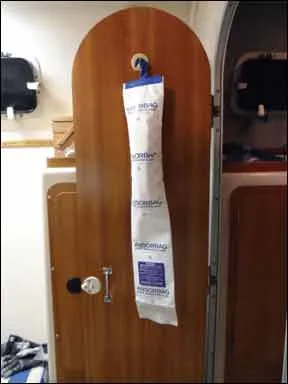
Photo courtesy of manufacturer and Drew Frye
What We Tested
Our principle aim for this test was to compare two active systems for removing moisture-compressor dehumidifiers and thermo-electric dehumidifiers-with each other, and then compare them with the passive desiccan’ts we looked at previously. Our compressor dehumidifier was a 40-pint Sears model (Kenmore/Hampton Bay Model BHDH4000ASO) that was unfortunately discontinued after our test had begun. We found several comparable dehumidifiers with similar specifications. The Danby Premiere 45 Pint Dehumidifier (model DDR45P), available from Home Depot (www.homedepot.com) for about $250, roughly matches the specs and appearance of our test unit. Sears and Amazon.com sell the EdgeStar 40 (model DEP400EW) for about $142.
Representing thermo-electric technology was the EDV2200 Electric Peltier Dehumidifier from Eva-Dry, which sells for only $70 online. Judging by the product marketing, users can save a substantial amount on upfront costs.
We also included two desiccan’ts, a small hanging Absorbag from Absortech, which uses calcium chloride, and a high-capacity tub of DampRid, another calcium chloride desiccan’t. Both of these products were also evaluated in our November 2012 comparison.
How We Tested
We had two test beds: The garden shed used for desiccan’t testing in the November 2012 article was used again for side-by-side comparison of the compressor dehumidifier, thermo-electric dehumidifier, and the desiccan’ts. We compared performance at warm, average, and low temperatures.
On the water, we used two identical staterooms on a catamaran to test the desiccan’t and thermo-electric unit through a Chesapeake Bay winter afloat. We measured water removal under relatively controlled conditions in the shed, and then again during on-board use. The test boat has a dry bilge and was sealed up tight except for a slight gap in the companionway that is protected from rain by a hard top. The boat was sailed about every two weeks, including a few two- to four-day cruises. Our tests did not simulate a situation with extensive onboard cooking.
Observations
Among the compression humidifiers, the Sears 30-pint unit was a workhorse, removing large amounts of water and operating well at all temperatures. Moisture removal dropped dramatically as temperatures fell, but that was primarily a consequence of the low humidity of cold air. For families living aboard and with access to shorepower or a genset, this may be the most practical solution.
In warm conditions, thermo-electric units can be expected to perform according to manufacturer specifications, but none we researched have de-icing cycles, so none are rated for use below 65 degrees. Below that temperature, frost begins to form on the cold plate, creating an ice block that remains until warmer temperatures allow melting. When ice covers the fins, the unit doesn’t work and is vulnerable to damage.
We combated this icing by providing a defrost cycle. To do this, we plugged the unit into a simple lamp timer and set it to run eight hours each day, allowing it to thaw the remaining 16 hours. We also tried controlling operating hours with a photocell lamp switch, so that the dehumidifier would go on at night, when temperatures are lower and relative humidity is higher. Eventually, the Eva-Dry would frost up, shut off (automatically controlled by the photocell switch), and then defrost during the day when temperatures rose. This setup reduced the operating hours, but it allowed the unit to function every day, except a few, without frosting up. The exceptions were particularly cold days, when the unit remained frozen through the day. On those days, there was so little moisture in the air that the frost build-up was minimal, and there was no damage to the unit.
While it is possible to build a 12-volt DC adapter cord as we did to power these units, we didnt find this practical. Generally, the draw is too great for a boat not on shore power, and we needed to use a 110-volt timer to prevent icing. There are 12-volt timers as well, but it is simpler to use these as 110-volt appliances.
We also realized that the Eva-Dry would need a drain in order to operate continuously and to prevent standing water from bursting the tank in subfreezing weather. A drain was easily fitted using a common compression fitting and a length of vinyl hose. We were concerned that the water in the hose would freeze, but because the unit removes very little water in sub-freezing conditions, there was not enough accumulation to cause damage. The unit operated from October though April without interruption.

For use in moderate temperatures, there are calcium-chloride desiccan’ts, which were well covered in the December 2012 issue. Calcium chloride is available in a wide range of packaging styles-gels, beads, crystals, powders, etc.-but they all work on the same principle. We have learned that calcium chloride, like all dehumidifiers, virtually shuts down when the temperature drops below 45 degrees. In part, this is due to lower absolute humidity, but there are also changes in crystal/solution equilibrium, and that makes the reaction rate 100 times slower in the winter than the summer. Dont expect calcium chloride to do much for you in the cold season, if there are any moisture leaks. It can sit there for a month, doing nothing.
Sears Dehumidifier
Our Sears 30-pint dehumidifier was a 1995-vintage compressor-type unit. It has been used to keep a storage shed dry for 17 years. In our warm-weather testing under conditions very close to those used for rating dehumidifiers (80-degrees and 70-percent relative humidity), it still performed very near to its maker specification. We would consider this to be a legitimate representative for all dehumidifiers of this type.
It was a bit loud to have in a small space, and it also produced a significant amount of heat; this was only a problem as outside temperatures rose in the spring. This specific model is no longer in production, but we found several others that matched its specifications in the same price range.
Bottom line: This technology is excellent for larger boats in very wet environments and for live-aboards. We Recommend it.
Mermaid Dry-Pal A marine-rated compressor dehumidifier, the Mermaid Dry-Pal is basically a more simple and rugged version of a home dehumidifier. We did not test this unit, but the owners we spoke with were happy with theirs. One unit had been in service for four years, the other six years, both without trouble. It has no defrost cycle, but since the owners are live-aboards, this was not an issue.
Bottom line: At about $500, it is twice as expensive as a home dehumidifier, hard for most sailors to justify. But for those needing higher capacity for long-term use, this is a product worth looking into. We will try to test it in the future.
Eva-dry 2200
In warm conditions, the Eva-Dry 2200 performed according to manufacturer specifications, removing one to two pints of water each day. However, just as the manufacturer stated, icing began at 60 degrees and became severe at 55 degrees. We successfully controlled icing by restricting operation to eight hours per day (as described above), and it still removed about seven times more water than the calcium-chloride desiccan’t drier we had hanging in the adjacent hull.
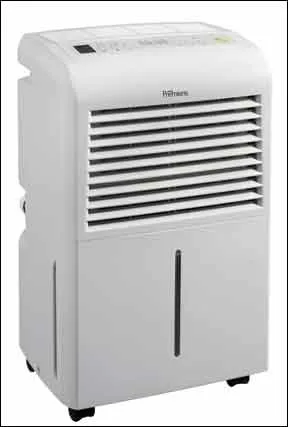
Although there is no humidistat in the unit, we found the Eva-Dry to be effectively self-regulating. As temperatures drop, there is less water in the air, and drying slows. As humidity becomes available and temperatures rise, capacity increases. The relative humidity stayed between 62 percent and 68 percent at the storage temperature-if the heat was turned on in mid-winter, relative humidity would drop as low as 30 percent-at all times, low enough to prevent condensation and mildew. A timer is also another way of providing some regulation.
To improve fire safety-always a concern with unattended operation-we placed the unit on the stove, and the power cord and 100-volt/12-volt adapter in the stainless sink next to it. To prevent standing water from bursting the collection tank in subfreezing weather, we added a drain hose. This was easily fitted using a common compression fitting and a length of vinyl hose that drained into a container for measurement; in actual use, this drain would go to the sink.
Did the hose freeze-up? Because the unit removes very little water in sub-freezing conditions, there was not enough accumulation to cause damage. (No dehumidifier or desiccan’t will remove much when its below 45 degrees as there is very little water vapor in the air.) What is the northern limit of this technology and defrost method? We believe it would work in any location where the water does not freeze for more than a few weeks; beyond that, we are uncertain.
Bottom line: Recommended for cruising boats 30 to 40 feet that are kept in the water.
Absortech Absorbag
The Absortech Absorbag functioned in much the same way it did in the December 2012 testing, passively removing water at a very slow rate. As temperatures dropped into the 40s, absorption practically stopped. It removed only a few ounces in January. This allows the unit to last through a season, but it cannot keep up with humidity generated by air leakage or even water evaporating from the hull.
Instead of removing gallons through the course of a season, it removed only about one pint, and most of that in the warmer months, never reaching saturation even after five months. Thus, its usefulness is limited to boats stored on land where electricity is not available, or for compartments that are kept closed. If more capacity is needed, consider four to eight of the more economical Damp-Rid High-Capacity desiccan’t tubs reviewed in the December 2012 article. (DampRid also sells a range of gel and hanging products that are less prone to spilling.) Adding a heating element like the Goldenrod, or even a simple light bulb, to confined areas or near a vent to promote air circulation can also help fight mildew.
Testers have also changed our opinion of the spill potential of the Absortech bags. The bag has lived at the foot of the most heavily used bunk through a five-month winter season, been bumped by sailors and duffels, and sailed in violent Force 7 conditions (we forgot it was up) while nearly full, without spilling a drop.
Bottom line: Recommended for cruising boats 30 to 40 feet that are sailed in the winter, though larger boats will certainly need multiple units.
Conclusion
Within four weeks of the start of the test, the faint but tell-tale mustiness we had lived with since we began boating 25 years ago vanished from the pillows, bedding, and stored clothing. That is the real bottom line. (The testers wife loves it.) All of the units we reviewed are useful tools, each with a proper application. Even though thermo-electric dehumidifiers are not intended for operation in cold climates, weve proven that with simple modifications, they are well suited to use aboard moderate-size boats that are stored in the water. We think there is an opportunity for some enterprising manufacturer to develop a marine-specific product.
What about summer? Desiccan’ts become useless, unable to cope with the volume of moisture, but our warm-weather testing suggests the Eva-Dry 2200 will have 20 times the capacity of the Damp-Rid High Capacity Absorber and 70 times the capacity of the small Absortech bag. Most sailors rely on ventilation, but were going to button up tight and continue running the Eva-Dry 2200 on a timer. By adjusting the timer, were hoping to keep the relative humidity near 65 percent, a practical maximum for reducing mustiness. Well report back in the fall.
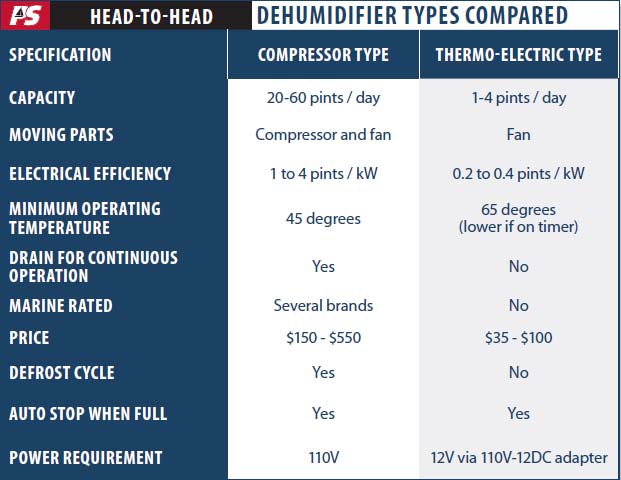
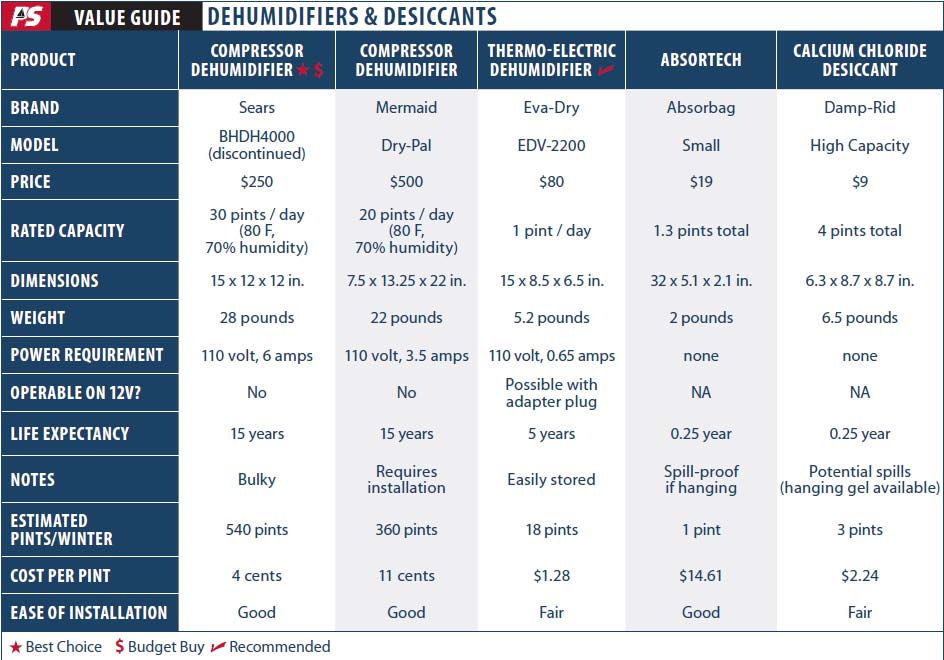
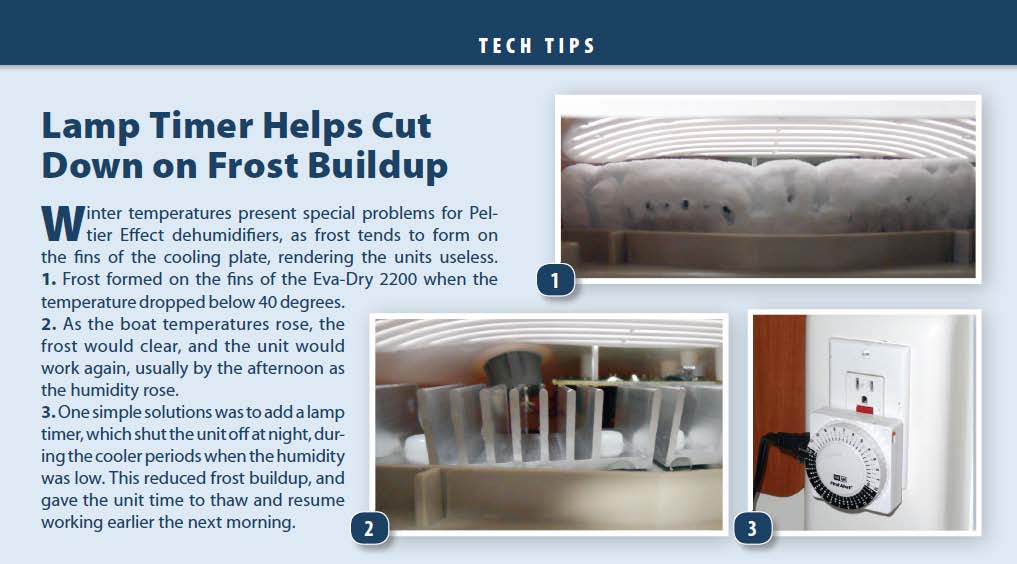




































I have two of the Eva-dry Petite 1100 dehumidifiers. They work great except the AC power adapter failed on both of them. The units lasted about a year each. The power supply is rated at 9.0V DC 2500mA output. A replacement power supply is almost half the cost of a new unit.
Hopefully the 2200 version has a better power supply.
Many years ago I had a mildew problem on my 28’ lobster yacht. The cabin was pretty small, just a V berth, small galley and wet head.
I tried many things but settled on a Peltier Effect dehumidifier. Like you I discovered that the tank filled quickly. I drilled a hole in the tank and just pushed an aquarium air hose into the tank. No fitting needed. It never leaked and it allowed me to drain the tank continuously into the sink.
It dropped the RH into the low 60% range. The mildew problem disappeared. The boat lived in the water in Miami. Freezing was not an issue and it handled the summer high humidity very well.
On my first one the fan died after about a year. I opened it up and discovered it was a computer fan. I was able to buy a replacement fan for less than $15 at a computer store.
Did you know that the Peltier Effect can also be used to generate electricity? You heat the bi-metal joints. I lit a flashlight bulb this way for a Junior High science fair. Not the most efficient way to generate electricity but it works.
I have a Pro Breeze 1500ml mini dehumidifier on my 35′ sailboat in Vancouver BC. I have been using it constantly since October. It is the second peltier effect dehumidifier I have owned. The first one was a different brand (Ivation) and lasted four winters.
I have found both models very effective, in combination with an electric heater (and two dorade vents which are always open). The heater keeps the humidifier working well as the temperature drops. My 20 amp shore power can handle the draw of the two devices easily.
It seems to work best when the heater is aimed at the air intake of the dehumidifier (from a few feet away).
The boat used to get a bit damp and musty over the winter, but this combination has made a great difference – I would highly recommend.
I’m a couple of years into using a rotary desiccant dehumidifier- a type apparently not tested- and could not be happier. This is in the Pacific Northwest, in water year round, with my main concern being wintertime temperature swings that can leave lots of condensation on the cold interior. The device has kept humidity to the 50% that I have set it to (it does have a readout for temperature and RH).
I found a UK site, Meaco.com, that sells and has info on all types. Their recommendation was that compressor types work well in warm environments, but become less efficient as temperature drops & they need more cycle time and power to defrost. Rotary desiccant types keep working to much lower temperatures. The takeaway was that if your temperatures are consistently above 50°F a compressor based dehumidifier may be best, but if your ambient temperatures will drop near or below that point you should consider a desiccant type- essentially a rotating desiccant sponge that is being continually squeezed dry. Because they don’t rely on a compressor, they keep working efficiently down to near freezing. My boat is firmly in the cold camp, since at the dock I run only a low wattage heater intended to avoid freezing. The one I purchased was Ivation, 13 pint small area unit. Boat is a 39′ cold molded sailboat. Cost was <$200.
I modified the catch tray and attached some tubing to drain to the outside thorough a sink drain. The built in hose connection was unreliable and the half-gallon capacity tray would need to be emptied at least daily otherwise. It shuts itself down if the tray gets full. The results have been night and day, with the boat staying dry and fresh. The unit does put out a small bit of heat as it operates, and it uses about 400 watts at full power. I have only ever run it at the lowest power setting, though. It pulls an impressive volume of water out of the air. Not a hint of condensation. It's one of the best boat investments I have made.
I have 32′ Island Packet which lives in Bellingham, WA year-round. I’ve been using the EVA-DRY unit continuously since 2013. Like an earlier comment, I have it on a timer so it runs across the night hours when the ambient temperature in the cabin is the closest to the dew point (cabin is not ventilated). I have had no mildew or dampness welcoming me to the boat after prolonged absence. For the first year, I inspected every space to see if the coldest locations (port glass, against the hull above the water line, bilge, etc.) had anything growing. Nothing ever. The fan is the highest probability failure point even though it’s brushless. I started with the 1100 and now use the 2200 only to increase the moisture removal when the winter watch guy opens the hatch. I tapped the tank and glued in a barb fitting and a short hose directs the water into the galley sink. Inside observations were the same whether 1100 or 2200. The 1100 uses a 9V adapter. 12V will work. It spins the fan faster. EVA-DRY sells a power connection that plugs into a cigarette lighter socket if one doesn’t wan to play with wire splicing and soldering. The 2200 runs on 12V. They will both run on the boat’s internal 12V system (1100 requires about 2A, 2200 requires 4A). It works at anchor! The fan is a small diameter muffin fan, the same kind we have in our desktop computers (see comment above). Easily replaced. I’ve recommended these units to my friends. Regarding defrost, it doesn’t matter. If ice forms on the heat sink fins, it will melt when the ambient temp comes back up. The requirement for airflow to keep a compressor motor cool doesn’t exist. It will dribble its condensate into the tank when frozen, but once melting takes place it will. Added note; we have an outdoor non-heated tack shed for saddles, etc. We use one there also continuously. No mildew anywhere. All that leather and copper decorations have no effects of condensate creating growths or oxidation.
I bought an Eva-dry Dehumidifier. I am interested in placing a drain hose as mentioned in your article. I was wondering what exactly you used for a compression fitting and hose (size, manufacturer, etc.).